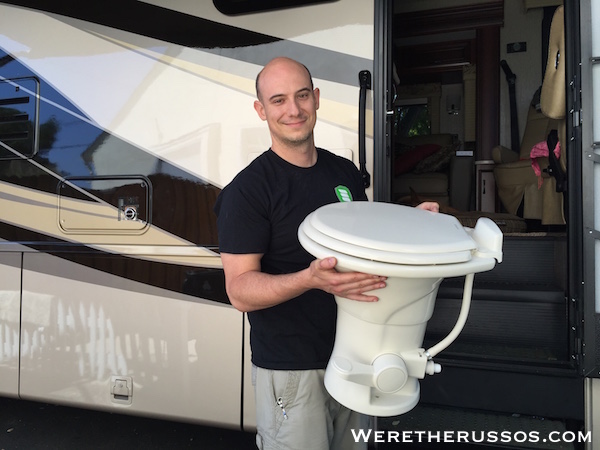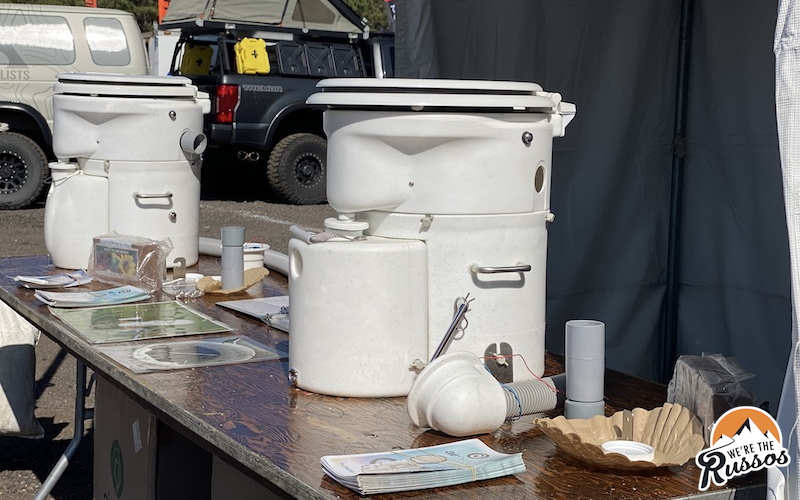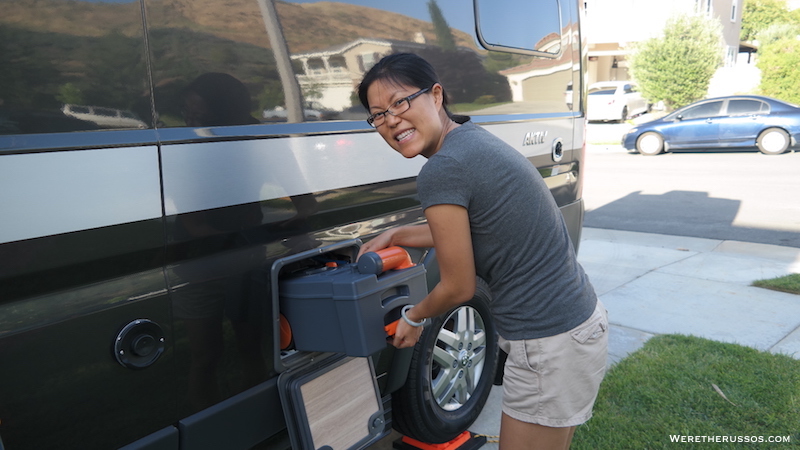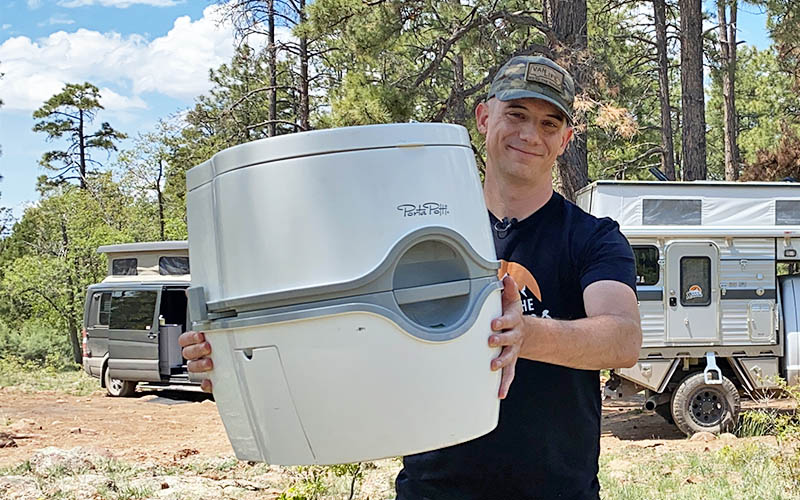This post may contain affiliate links.
Whether you’re new to RVing or just shopping for a new RV toilet, you might be thinking, “I wish there was a comprehensive resource that could answer ALL of my questions about RV toilets.” Well, you’re in luck! You’ve got questions—we’ve got answers, and we’ve written this article to be the ultimate resource on RV toilets.
It’s a dirty topic, but someone has to cover it. In fact, the questions we get asked the most are all about “the bathroom situation” inside an RV.
After all, when you’re moving from a house with running water and a porcelain throne to an RV, the stakes feel high. What will happen when you need to “go”? And who will handle the aftermath?
Everybody poops… but not everyone has to deal with the results as intimately as we RVers do. Here’s everything you ever wanted to know about RV toilets (and probably more).
Types of RV Toilets
Whether you’re already familiar with the landscape of RV toilet options or not, we thought we’d start with a quick orientation to get things rolling. So, here’s a rundown of all the different types of RV toilets out there. (If we’re missing one, please let us know in the comments—we’d love to hear from you!)
Table of Contents
- Gravity Flush Toilets
- Composting Toilets
- Cassette Toilets
- Portable Toilets
- Incinerator Toilets
- Macerator Toilets
- Cat Hole
- How does an RV toilet work?
- What’s the Best Toilet for an RV?
- Is RV toilet paper necessary?
- How can I stop my black tank from smelling?
- Can you put a regular toilet in an RV?
- Are all RV toilets the same size?
- How to remove an RV toilet
- How to install an RV toilet?
- How much water does an RV toilet use per flush?
- How to flush an RV toilet
Gravity Flush Toilets

Most RVs on the market come standard with a gravity flush toilet. In fact, if there’s no mention of what kind of toilet an RV has, it’s a safe bet that it’s a gravity flush style. This type of RV toilet is the closest in appearance to a residential plumbed-in toilet… but only in appearance.
Gravity flush toilets are typically made of porcelain (in higher-end models), just like a residential toilet, or plastic. Most have a foot pedal flush that opens a hatch at the bottom of the bowl. The pedal also rinses the bowl with water when you’re finished.
Waste and rinse water then fall (thanks to gravity) into a black tank, which holds everything until you evacuate it through a sewer hose at an RV dump station. (It sounds worse than it is.)
Pros of Gravity Flush Toilets:
- Most RVs come equipped with gravity flush toilets, so there’s little to no planning involved. The plumbing is generally all there and ready to go.
- Dumping the black tank really isn’t that bad. With a black tank prep like Happy Camper, there’s no crazy smell or buildup, either.
Cons of Gravity Flush Toilets:
- They use a lot of water, which is important if you plan to do a lot of boondocking.
- You do have to dump your waste through a sewer hose. While we didn’t find it that bad, some people (understandably) just don’t want to get that close and personal with sewage.
- You have to find an RV dump station when it’s time to empty the waste holding tank.
Popular Brands of Gravity Flush RV Toilets:
Composting Toilets

We’ve met many people who prefer composting toilets over traditional gravity flush models. In fact, almost every time we hear about someone swapping out the toilet in their RV, it’s to replace the standard gravity flush toilet with a composting toilet.
The perks are numerous: composting toilets are more environmentally friendly, use little to no water, and allow you to go longer between dumping (the solid waste, that is).
Composting toilets generally separate liquids from solids, and the combination of the two is what creates sewage. With a composting setup, you simply dump the liquids into a public toilet or, if acceptable by local regulations, dilute it and sprinkle it on the ground.
You mix your solids with a composting medium like coconut coir, which eventually breaks them down into compost. When the toilet is full of compost, you can put it into a compostable bag and drop it in the nearest dumpster—or even use it as fertilizer for non-edible plants.
We wrote a whole article all about composting toilets if you really want to dive deep into the most popular brands. We also share our not-so-great early experience with a composting bucket toilet.
Pros of Composting Toilets:
- They’re the most environmentally friendly option, since you’re not creating sewage or using drinking water to flush your waste. You’re also creating (potentially beneficial) compost in the bargain.
- Because they don’t require water, you can go dry camping longer without having to dump. Since you won’t need your black tank, you can combine your black and gray tanks into one huge gray tank. All of this means you can camp in the wild much longer.
Cons of Composting Toilets:
- Sourcing composting medium like coconut coir can be difficult, depending on where you are—and don’t forget, you’ll need space to store it.
- Dumping your liquids can be awkward. If you’re going to dump in a public toilet, it means you’ll be carrying a bottle of pee around while you’re in transit. You’ll probably also have to dump your liquids fairly often, since the liquid tanks are small.
- We’ve heard that odor can be an issue with the liquid portion. Try using white vinegar to help with this.
Popular Brands of Composting RV Toilets:
Cassette Toilets

What is a cassette, if we’re not talking about early 90’s audio? If you followed our travels in the Ram ProMaster Class B van, you know that we used a cassette toilet for a couple of years and loved it! In fact, I dumped that toilet solo for the entire first year we had the van because it really wasn’t a big deal.
Most recently, we got to revisit the cassette toilet while testing the Storyteller GXV HILT, and it reminded us how much we enjoy using this type of RV toilet.
Basically, with a cassette toilet, you have the same permanent toilet you’d see in a gravity flush setup. However, instead of collecting waste in a fixed black tank, it’s collected in a portable tank (or cassette).
Cassettes look almost like a suitcase, complete with a handle and wheels for easy rolling (though we wouldn’t recommend bringing one as carry-on). When the tank is full, you simply open an outdoor bay, pull the “suitcase” out, and wheel it to the nearest dump station or public toilet for emptying.
When we rented a camper van in Italy, every campground we stayed at had a designated cassette toilet dump station. You can get an idea of what it’s like to dump a cassette toilet in Europe by watching this video.
Pros of Cassette RV Toilets:
- They’re very easy to use and dump.
- When the tank is full, there’s no need to move your whole RV to the dump station or sewer hole. You can just take the cassette!
Cons of Cassette RV Toilets:
- Depending on how you use it, you may actually end up closer to the icky stuff with this toilet than with a gravity flush.
- Because they’re small enough to wheel around, cassettes have smaller capacity than permanently mounted black tanks.
Portable Toilets

One of our favorite types of RV toilets is the portable toilet. We used a Thetford Porta Potti in our 4×4 truck camper for two years while traveling full-time. Now, we use the Dometic portable toilet that came with our Transit camper van.
This type of toilet is like a logical extension of the cassette toilet. But instead of having a normal-looking toilet that drains into a portable tank, the portable toilet (or porta potti) is essentially a portable tank with a toilet seat on top.
You can take the whole toilet with you anywhere since the entire setup is portable and easy to move. Portable toilets are also one of the most cost-effective (and space-efficient) options available. They don’t take much time or effort to install, either. If you’re in a hurry, or just impatient, that’s okay—just plunk it down and go!
Pros of Portable RV Toilets:
- They’re inexpensive and easy to install. No tools required, unless you want to mount a base to your floor to prevent any shifting during transit.
- You can take them anywhere! If you’re changing RVs, going car camping for a weekend, or just want to take yours with you on a day trip, you have that option.
- They use very little water for flushing. Ours comes with a small water tank that you can use to help rinse or flush if needed, but often it’s not necessary.
Cons of Portable RV Toilets:
- As with cassettes, the dumping process is a bit more up close and personal (potentially) than dumping a black tank with a sewer hose. You don’t have the large valves to seal the whole process from view.
- Tank size is generally pretty small, so you can’t stay out as long with these types of toilets as you can a standard gravity flush with a large black tank underneath.
Popular Brands of Portable RV Toilets:
Dry RV Toilets:

Dry flush toilets are a popular type of portable toilet. We cover dry toilets in more detail in our article on portable toilets if you just can’t get enough toilet talk.
Dry toilets are fully portable and use no water to flush. Instead, waste is wrapped in a material that looks a lot like thin aluminum foil, along with a powder that turns your deposit into a gel for easy disposal. When done, you’ll end up with a bag or packet that you can simply throw into a garbage bin.
Popular Brands of Dry RV Toilets:
Incinerator Toilets
Now we’re getting into some of the more unconventional types of toilets. Honestly, the incinerator toilet is one that blows my mind a little.
I mean, it’s pretty amazing that you can have a unit inside your RV that turns your waste into a small pile of ash—less than a tablespoon of ash for every 3-4 uses, to be precise.
Similar to the dry flush toilets we described above, you’ll need to purchase special toilet bowl liners to use an incinerator toilet, so costs can add up quickly. This is something to keep in mind if you’re living in your RV full-time, especially with a family.
Here’s how incinerator toilets work: You push a button to incinerate your waste, and the bowl is heated to 1,200 degrees Fahrenheit. An exhaust vent routes the smoke outside. The whole cycle takes about 2 hours, but don’t worry—you can still use the toilet while that’s happening.
Popular Brands of Incinerator RV Toilets:
Macerator Toilets
Here’s one “con” we didn’t mention with gravity flush toilets (or, frankly, any RV toilet that requires water and has a storage tank): the “poo pyramid.”
This pyramid can form if you have too many solids in the tank and not enough liquids. The waste and toilet paper create a mound that becomes nearly impossible to remove if it gets large enough—which is why there’s actually such a thing as an RV proctologist.
A macerator toilet prevents this issue by pulverizing waste, functioning much like your garbage disposal at home. This means that blockages caused by wads of toilet paper (or other items) won’t occur. You’ll also have a lower risk of clogs in your sewer hose during dumping.
Pros of Macerator RV Toilets:
- They can pump waste up an incline
- Smaller sewer hose diameter means less odor while dumping
Cons of Macerator RV Toilets:
- Dumping tanks is slower with a smaller hose
- Requires more water and electricity than any other type of RV toilet, which means that if you’re interested in camping without hookups, this may not be the toilet for you.
Popular Brands of Macerator RV Toilets:
Cat Hole
Since we’re aiming to be as thorough as possible, we figured we should mention the good old-fashioned cat hole.
If none of the above options feel like a good fit for your rig—and you prefer to experience nature with no barriers between you and the great outdoors—the cat hole might be for you. All you need is a shovel and good balance.
If you choose this option, please research how to do it safely and check the regulations for the area you’re in. Plan to dig a hole at least 6 inches deep and bury everything when you’re done. Of course, steer clear of streams and rivers to avoid contaminating water sources.
And pack out your toilet paper, as animals tend to dig it up and spread the trash around. Reusable pee cloths have become more popular in recent years and are an option to consider to cut down on toilet paper use for number one.
How does an RV toilet work?
At the most basic level, you just need a toilet with a small enough footprint to fit inside an RV. Then, you need a plan for the destination of your liquids and solids. Is everything going to the same place, or are you separating them?
All of the different RV toilets described above work differently, but the goal of all of them is to provide a safe, sanitary receptacle for your waste. When we live in a sticks and bricks house, we’re used to the luxury of our waste being out of sight and out of mind, with a simple flush of the handle. In an RV, which is a closed system that you bring with you, it isn’t quite so simple!
What’s the Best Toilet for an RV?
As you can probably tell from the pros and cons listed for each toilet above, the best toilet for your RV will depend on your camping style, budget, and personal preferences. Here are some questions to ask yourself when making a purchasing decision:
- How often do I want to stay in one spot without having to dump?
- What kind of “dirty jobs” am I willing (or unwilling) to do?
- Will I want to conserve water and/or electricity, or mostly be camped with hookups?
- How much am I willing to spend?
- Can I replace my current toilet myself? What tools/expertise are required?
Frequently Asked Questions about RV Toilets
Is RV toilet paper necessary?
Most experienced RVers who do use their black tanks will tell you no—you don’t need to use the very thin, very expensive RV toilet paper that’s rated as safe for your RV’s sewage system.
However, you do need to be careful about the toilet paper you flush into your tank; not all residential toilet papers are created equal. The best toilet paper to use in an RV is a judgment call, but lots of RVers like Angel Soft or Charmin Ultra Soft.
The Fit RV created a great video on how you can test different toilet paper brands for yourself. Basically, you want to shake a couple of squares with water and see if they start to break down within about an hour. If they don’t, don’t put that toilet paper into your tank! If they dissolve in that time, you’re good to go.
How can I stop my black tank from smelling?
There are lots of chemicals out there that are marketed to stop black tank smell, but we prefer Happy Camper. It’s an organic tank treatment that left our bathroom without any odor whatsoever.
A great way to “charge” your black tank (or, prepare it for use after dumping) is to put a few gallons of water into it along with a scoop of Happy Camper. You can add some Dawn dish soap and Calgon water softener if you really want to clean your tank out while you’re going down the road.
Adding a good amount of water is key. You want to put 3-5 gallons of fresh water into your black tank before you start using it, for a couple of reasons. First, this is crucial for keeping odor down. And second, you’ll prevent the dreaded “poo pyramid” if you get lots of liquid in there from the get-go.
Can you put a regular toilet in an RV?
Well … sort of, but not really. Residential toilets have a large water tank and are designed to connect to residential plumbing. Not to mention the fact that they’re heavy. There’s no way to connect one of these types of toilets without a serious overhaul of your RV’s innards—and they’re way too heavy, anyway.
But, with a porcelain gravity flush toilet, you can get pretty darn close to the residential toilet experience. With the added adventure of flushing your black tank every once in a while.
Are all RV toilets the same size?
No! They definitely aren’t, so if you’re replacing yours, be sure to measure the space you have available. Some RV toilets can be a significant investment, and you don’t want to end up with something that doesn’t fit your space.
How to remove an RV toilet
The exact details will depend on the brand of toilet you have, but if you’re removing a standard gravity flush toilet and replacing it with either another gravity flush or a different type of toilet, here are the basic steps you’ll want to follow:
- Shut off the water, hold down the foot pedal to release any residual water pressure, and disconnect and drain the water supply lines running from your fresh tank/water system to your toilet
- Remove the nuts and bolts at the base of the pedestal that connects the toilet to the floor. Generally there are two of these, one on each side.
- Lift the toilet and remove it.
- Remove and discard the old floor flange seal and bolts
How to install an RV toilet?
Installation will vary depending on the type of toilet you install.
For instance, if you’re replacing a gravity flush toilet with a composting toilet (or other type of toilet that has a fan, like an incinerator toilet), installation can get complicated. If electricity is required to run a fan, you’ll need to wire the toilet into your RV’s electrical system (not recommended unless you’re comfortable working with electric).
You may also need to put a hole into the side of your RV for the vent, so proceed with caution! Consider having a professional do the install, and preferably one who has installed your type of toilet before.
Installing a gravity flush toilet in an RV that already has one is pretty easy. If you’re a visual learner, Mark Polk has an excellent video on how to remove and install a traditional gravity flush RV toilet.
For composting toilet installation, you can learn a lot from the “how not to” video made by the Wynns.
One of the reasons why we love our portable toilet so much is that installation couldn’t be easier. In fact, you don’t necessarily even need to install anything. You can just set this type of toilet on the floor of your RV and drive on! However, to prevent any sliding around during transit, you might install a simple floor mount to keep the toilet in place.
How much water does an RV toilet use per flush?
We hate to sound like a broken record, but it depends on what kind of toilet you have. The nice thing about RV toilets (versus residential toilets) is that you can control how much water is used. It’s not like a plumbed-in toilet where you push the handle and the toilet takes over from there.
With a gravity flush toilet, you can hold down the foot pedal as long as you like. You basically just want to use enough water to rinse the bowl, so it will depend on whether your “deposit” was liquid or solid. Most flushes will be maybe ½ cup to 1 cup of water.
Some RV toilets, like a composting toilet or dry flush portable toilet, use no water at all.
Portable toilets like ours do have a small water tank to use while flushing. We probably use ¼ cup or so per flush, just to quickly rinse down the bowl.
How to flush an RV toilet
You know the answer by now: it depends.
Most RV toilets have a foot pedal flush. If you step all the way down, the water will rinse the bowl and the door at the base of the bowl will open, allowing the waste and rinse water down into the black tank. Stepping halfway down on the foot pedal will just run rinse water into the bowl, so you can fill the bowl for cleaning or prepping the tank.
Portable toilets might have a push button or pull handle to open the “trap door” into the holding tank. The dry flush RV toilets that have proprietary liners and run on electric will generally do the work for you with the push of a button.
With a composting toilet, you don’t want any liquid to get into the solids tank. So you’ll first wipe any residue from the bowl with toilet paper, then turn a hand crank to mix your most recent solid into your composting material. You might just use ¼ cup of water or so to quickly rinse the bowl after you’re done, making sure it all ends up in the liquid tank.
The “Bottom” Line
There you have it—our round-up of answers to all the questions we hear about RV toilets. We’ve done our best to create the best resource on RV toilets out there.
If you have any questions that we didn’t answer, please let us know in the comments and we’ll do our best to address them.

I have vacuflush toilets in my 2018 Bounder. Hate them with a passion. Nothing but trouble! ANY way to take them out and install gravity toilets?
Hi Tom – unfortunately I think you’re out of luck. The Vacuflush system is used because the toilet is not directly over the black tank like it is in a gravity system so it’s used as a pump to move the waste from the toilet to the tank. I’d suggest doing some more research to see if you can find people who may have changed out the system for something like a macerator toilet which grinds up the waste and pumps it into the tank.
Waste disposal is not a pleasing topic, especially when you’re having meals. However, you need to deal with it as a result of eating.
I have a 2017 class A holiday rambler and it has a VacuFlush toilet.
https://www.etrailer.com/Accessories-and-Parts/Dometic/DOM46FR.html#exp-productdetails=.reviews
Never heard of one till I bought the RV.
Many of the Boondocker campers whether the Truck Camper or Van camper people on youtube, I have been finding many are opting for the Composting toilets.
There was one Fifth wheel Boondocker that actually ripped out their standard RV flush toilet which was purchased built into the camper and replaced it with a Compost toilet.
Good evening to the two of you. Thank you for posting this blog. It has been a topic of debate between my wife and I all through our planning process.
Could you please comment on the use of a 5 gallon bucket, liner, toilet seat, and pop up privacy booth. Have you used or came in contact with others during boondocking who use such a set up where you could shed some light on experienced or envisioned pros and cons of this option.
Thank you.
Hi Dan, we have met quite a few people who use the 4th toilet listed in the portable camping toilet article and they swear by it. We don’t know anyone personally who uses the pop up privacy booth, but we have seem them while camping out in the national forest.